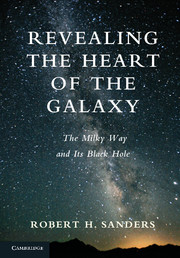Book contents
- Frontmatter
- Contents
- Acknowledgements
- 1 Introduction: The Luminous Pathway
- 2 The Discovery of the Milky Way Galaxy
- 3 The New Physics
- 4 Parting the Veil with Radio Astronomy
- 5 The Violent Universe
- 6 New Windows on the Galactic Center
- 7 The Milky Way as a Barred Spiral Galaxy
- 8 The Evolving View of Active Galactic Nuclei
- 9 The “Paradox of Youth”: Young Stars in the Galactic Center
- 10 Stellar Orbits in the Galactic Center, QED
- 11 Black Holes Here, Black Holes There…
- 12 Traces of Activity: Past, Present, and Future
- 13 After Words: Progress in Astronomy
- References
- Index
12 - Traces of Activity: Past, Present, and Future
Published online by Cambridge University Press: 05 December 2013
- Frontmatter
- Contents
- Acknowledgements
- 1 Introduction: The Luminous Pathway
- 2 The Discovery of the Milky Way Galaxy
- 3 The New Physics
- 4 Parting the Veil with Radio Astronomy
- 5 The Violent Universe
- 6 New Windows on the Galactic Center
- 7 The Milky Way as a Barred Spiral Galaxy
- 8 The Evolving View of Active Galactic Nuclei
- 9 The “Paradox of Youth”: Young Stars in the Galactic Center
- 10 Stellar Orbits in the Galactic Center, QED
- 11 Black Holes Here, Black Holes There…
- 12 Traces of Activity: Past, Present, and Future
- 13 After Words: Progress in Astronomy
- References
- Index
Summary
Effects of Black Hole Outbursts on the Galactic Center Gas
Some catastrophic events on Earth have a long-term drastic impact on the geology of the planet and biological evolution. Others have dramatic but short-lived effects. Examples of the first category would be volcanic eruptions that can create mountains or islands à la Pele, and collisions with astroids or comets that produce enormous craters and destroy many life forms; such episodes create relics that can persist longer than the time interval between these events. Examples of events with short-term effects would be earthquakes and tsunamis that can be devastating locally but with few long-lasting consequences on the structure of the Earth (apart from accumulative effects of many such events). While a tsunami creates a ripple on the surface of the ocean that can flood and destroy vast distant coastal regions, the long-term global effects of a single such event are negligible.
Into which category would the hypothetical occasional eruptions at the Galactic Center fall? What is the effect of outbursts of the black hole on the surrounding environment? How long do such effects last and how far do they extend into the Milky Way? It is certain that the black hole is presently inactive – in fact, almost embarrassingly so. In 2001, using the Chandra satellite, F.K. Baganoff and collaborators detected X-ray emission from Sgr A*, quite possibly due to thermal emission from hot gas in the near vicinity of the black hole.
- Type
- Chapter
- Information
- Revealing the Heart of the GalaxyThe Milky Way and its Black Hole, pp. 165 - 176Publisher: Cambridge University PressPrint publication year: 2013



